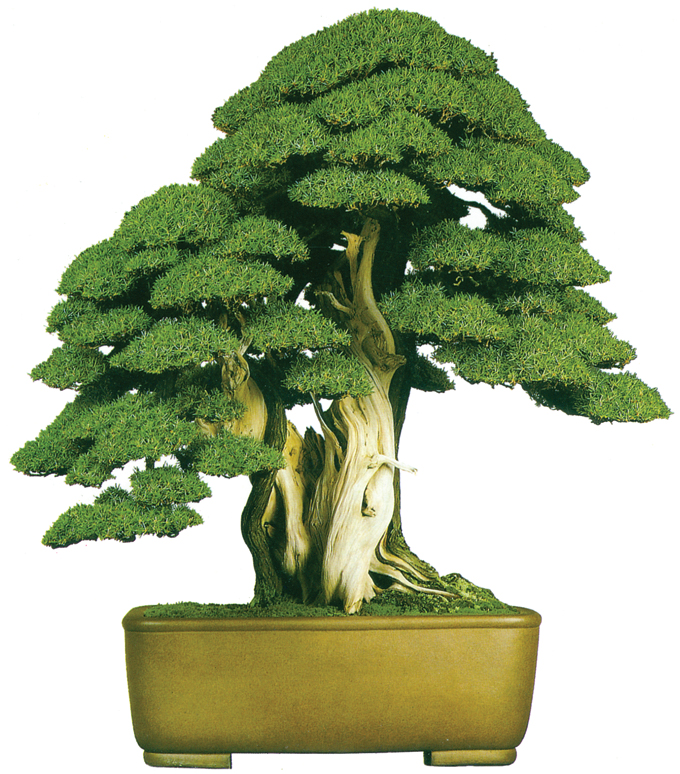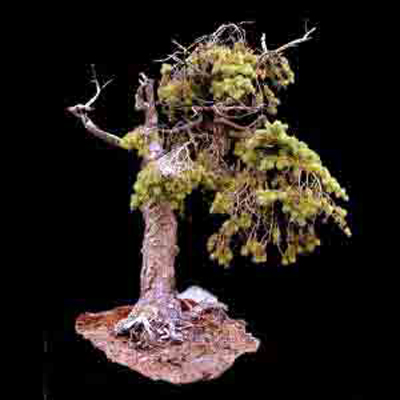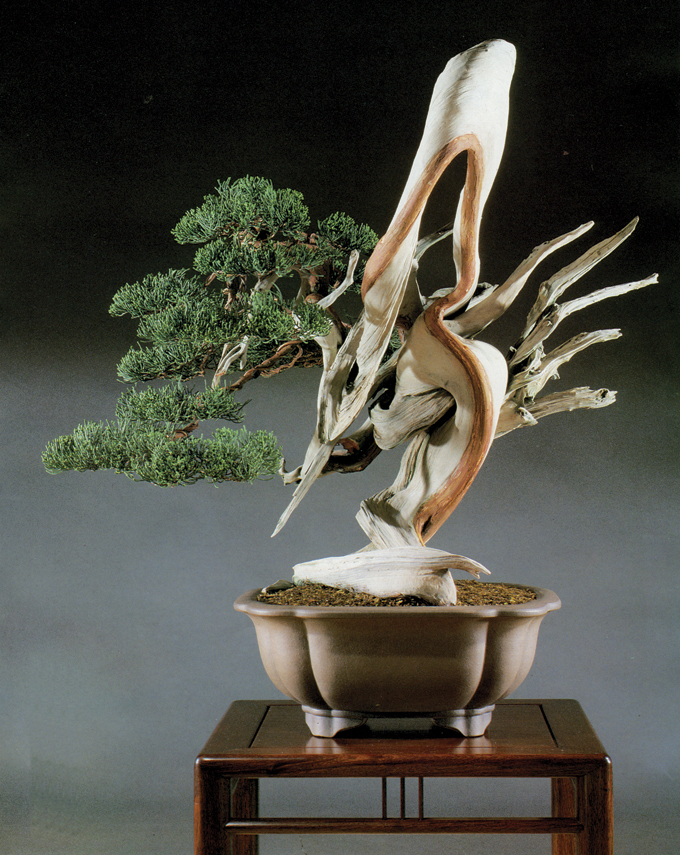 Can you imagine the time needed to develop and maintain the numerous foliage clouds? Does this level of refinement exist outside of Japan? Needle juniper (J. rigida) by Shinji Suzuki. From our Masters’ Series Juniper book.
Can you imagine the time needed to develop and maintain the numerous foliage clouds? Does this level of refinement exist outside of Japan? Needle juniper (J. rigida) by Shinji Suzuki. From our Masters’ Series Juniper book.
Picking up where we left off
Our last post provoked more discussion than any post so far. Roughly drawn, the topic is naturalistic bonsai versus highly stylized and highly refined bonsai. I thought it might be good to continue with examples that exist at the extremes, at least in my view.
 This Big cone Douglas fir by Dan Robinson jumped out at me because it seems so absolutely raw. Apologies for the fuzzy photo. I picked it up off of Dan’s website. It doesn’t appear in Gnarly Branches, Ancient Trees, though many other examples of Dan’s very raw bonsai do.
This Big cone Douglas fir by Dan Robinson jumped out at me because it seems so absolutely raw. Apologies for the fuzzy photo. I picked it up off of Dan’s website. It doesn’t appear in Gnarly Branches, Ancient Trees, though many other examples of Dan’s very raw bonsai do.
 Would you dismiss this amazingly dynamic tree because it doesn’t quite look like any tree in nature? Shimpaku juniper by Masahiko Kimura, a master of stylized bonsai who has no problem creating more naturalistic trees as well. From our Masters’ Series Juniper book. There are also numerous examples of Kimura’s bonsai in The Magician, another Stone Lantern Masters’ Series book.
Would you dismiss this amazingly dynamic tree because it doesn’t quite look like any tree in nature? Shimpaku juniper by Masahiko Kimura, a master of stylized bonsai who has no problem creating more naturalistic trees as well. From our Masters’ Series Juniper book. There are also numerous examples of Kimura’s bonsai in The Magician, another Stone Lantern Masters’ Series book.
I beleive there exists room in any bonsai collection for both styles of bosaiand they both have merit and beauty. No artist would intentionally restrict themselves to one style of art except through the natural constraints of ones own habit of discipline , why should we as artists?
Bonsai is no longer strictly a Japanese art form anymore. Over the past several decades, it has spread into a world wide passion. When the Japanese adopted it from China, they changed it completely from it’s original form and made it their own. I believe that it’s only natural that as bonsai continues to be adopted by other regions and cultures around the world that each of them will develope their own styles. Why would we as mostly American bonsai artists, spend our time trying to imitate Japanese trees! We have some of the most beautiful trees and landscapes in the world right here in our own back yards to draw our inspiration from! I’ve been studying Bonsai for almost 25 years. I’ve never been to Japan, much less seen a Japanese tree growing in it’s natural habit. Why should I limit myself to trying to re-create something I’ve never experienced for myself? I think we SHOULD develope our own style, taking inspiration from our own part of the world, just as the Japanese did centuries ago. Although I have a deep appreciation and respect for the Japanese style, let’s let the Japanese do their thing, and let the rest of the world do their own!
There’s another factor, a huge one, that differentiates Japanese bonsai from the rest of the world. In Japan, most bonsai are carefully developed by the bonsai industry over many years in traditional styles, or are wild collected trees which are styled and re-styled over time by bonsai masters who also care for theim for their owners. In America, Europe, and in fact just about everywhere else, bonsai are grown or aquired from wild or nursery trees and developed by the individual bonsai artists. Of course, Europeans also import from Japan many conventiionally wonderful trees but they achieve artistry in their native species which they collect and style.
This wonderful situation has resulted in an explosion of individuality and creatiity around the world. I enjoy looking at Japanese trees and there are some very creative individuals in Japan. We also owe them deep gratitude for the refinement and techniques which have been developed there and shared with us, but most of the amazing work in bonsai is happening elsewhere, done by artists who grow, collect, design and care for their own trees.
Hi Wayne. I’ve been following the discussions here with interest, but at this point I want to merely jump in to correct the info about Dan’s Big Cone Doug fir pictured above: It is indeed pictured in Gnarly Branches, on page 138, in the chapter, Fundamentally and Intuitively an Artist. It is a tree he has left completely un-styled, just as it was collected in the Rockies, so it’s not really an example of the “naturalistic style” I suppose. Here’s a quote from the book’s narrative that talks about this tree:
“Dan leads her a few feet down to the opposite side of the path, where an ancient Large Cone Douglas fir sits on a rock, in its natural, untrained splendor.
“I collected this venerable old guy in the mountains above Boulder, Colorado years ago. It was just so beautiful, sitting on a rock slab not too different from the one it’s on now. It didn’t have a single root going off into the surrounding soil to anchor it. I couldn’t believe it, so I shook on it, and it moved pretty freely. Well, then I just lifted it up, and it came right off the rock! I wrapped it up and brought it to Elandan, and just stuck it on this new rock here, and it never even knew anything had happened! No set back at all. What a great tree.”
Thanks Will, That helps. Great story too.
I missed it when I looked through the book for it. Different photo fooled me (not always difficult to do).
Dan shows it on his site under ‘bonsai museum’ with the sub section called ‘tree collection’. At the risk of being a little stubborn, I think it could be viewed as a completely raw naturalistic bonsai. In any case, raw naturalistic bonsai or simply a potential bonsai, I agree, it’s a great tree.
I think you are right, Wayne. It is indeed a completely raw naturalistic bonsai, and as such it is entirely in keeping with what I understand the origins of bonsai to be: trees brought down from the mountains by the ancient Chinese, to adorn their homes with a reminder of nature’s beauty. This tree of Dan’s is certainly a direct descendant of that tradition.It is a very difficult tree to photograph well, BTW, and my photo from the book – the result of much patience and effort – turned out only slightly better than the one you copied from the Elandan website. To see it in person, however, is an impressive experience that really does evoke images of the mountains it came from. Great example to choose for this discussion.In the Foreword to Gnarly Branches, as he has elsewhere I believe, Walter Pall draws on the image of a continuum of trees spread out before us, at one end of which is a highly stylized tree in the Japanese tradition, and at the other end of which is an extreme example of the naturalistic style, such as this tree of Dan’s. Walter points out that , “In art appreciation the word ‘style’ refers to a general feeling, an overall philosophy, an overarching way of going about things, an artist’s general frame of mind.” He then points out that an art museum has different rooms devoted to different styles, within which one can find all the common forms of the art, landscapes, a lady sitting, still-lifes, etc, and he then addresses a common theme in online discussions: whether bonsai is an art. “This is how we know bonsai is an art form: the different styles show exactly this. If bonsai were a craft there would be only one ‘right’ way of doing it. Instead we find many styles … In all these styles, you will also find the standard bonsai forms: formal upright, informal upright, slanting, cascade, and so on.” For me, these thoughts by Walter bring great clarity to such discussions.
Thanks John,
Agreed. I’ve been agreeing a lot lately, with some caveats. Perhaps one caveat has to do with the idea that there are only two styles: naturalistic vs highly refined more abstract bonsai. Not that it’s not convenient and not that I (and others) haven’t provoked this discussion by positing two styles, still, perhaps it’s a question worth exploring.
Thanks Dave Piemme,
Yes. Agreed. Though there’s certainly nothing wrong with an American (or other) bonsai artist allowing themselves to be heavily influenced by Japanese bonsai, even to the point of imitation. Lot’s of artist learn by imitating other artists. Sooner or later, one’s own style emerges (well, maybe).
Thanks Carol,
Good points. Agree we owe a lot to the Japanese artists. Such a solid foundation to learn from and still more to learn than we might think. Though I agree about the explosion of creativity around the world, I would include Japan as part of that explosion, a place where amazing bonsai still happens.
Thanks again Will.
What Walter says about differing styles is how we know bonsai is an art form, is thought provoking.
Sometimes I’m not sure if it’s so important whether we consider bonsai an art. Perhaps bonsai is limited in a way that other art forms aren’t (the trees are alive and ultimately nature rules), but frankly I haven’t thought this one through and expect I’m opening myself to strong disagreement (and perhaps more comments!).
Interesting to note that the Douglas-fir shown above is not a bonsai. It is a wild tree transplanted from one boulder (in the Rockies) to another (on Puget Sound). I’ve seen it at Elandan, and it’s also a rather large specimen.
If you’re ever in the Pacific Northwest, you owe it to yourself to visit Elandan Gardens. The place is stupifying.
Thanks Al,
One of these days I’ll make it back to the Northwest. I have a hankering to revisit the Olympic rainforest. And of course, Elandan.